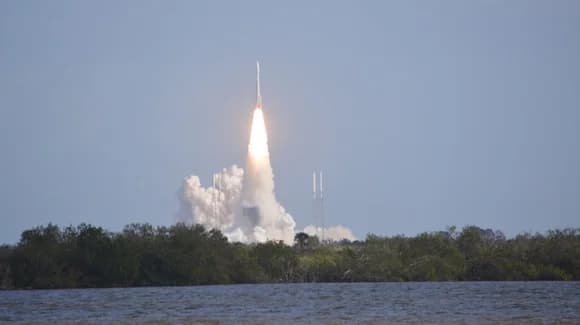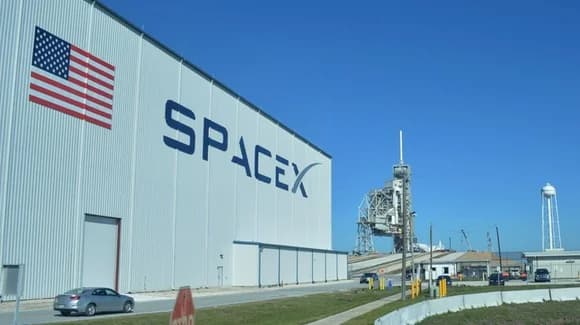NASA Constellation Program

To the Moon, Mars and Beyond
With the existing Space Shuttle fleet being retired in 2011 when construction of the International Space Station was effectively completed, NASA looked to two new space programmes.
In the first program, NASA signed agreements with Space Exploration Technologies of El Segundo, California and Rocketplane-Kistler of Oklahoma City to build launch vehicles capable of launching astronauts and cargo to service the International Space Station. First demonstrations were expected as early as 2008 but the contracts were terminated in 2007 when milestones were not met.
The second program was the NASA Constellation Program. Constellation was designed for a return to the moon mission but could also be used to service the International Space Station and ultimately provide crew transfers for missions to Mars.
NASA reverted back to a Saturn/Apollo style solution as a safe, reliable and cost-effective space transportation system, but using the latest technologies and proven engineering designs from more recent programs including the Space Shuttle.
The Constellation programme consisted of two different Ares launch rockets and an Orion crew exploration vehicle.
Missions to the Moon would require the launch of two rockets; an Ares I to put the Orion crew capsule into low earth orbit and an Ares V to deliver the Lunar Surface Access Module (LSAM - the modern equivalent of the LEM lunar lander from Apollo days). Once in earth orbit the Orion capsule would dock with the LSAM before breaking out of earth orbit and heading for the moon.
Initial Ares test flights were scheduled for Spring 2009 with the first manned flight of Ares/Orion scheduled by 2014 and a flight to the moon planned by 2020. In the end, the first test flight took place on October 28, 2009.
Budget constraints forced NASA to extend some of the schedules and first low-orbit tests were pushed back from 2012 to 2014 and first manned flight to March 2015. However, this all came to nothing as the Obama administration threatened to pull the plug on the entire programme and ultimately cancelled Ares completely in 2011.
The Orion crew capsule design was modified to work with a new rocket system called the Space Launch System (SLS).
The Orion contract was awarded to Lockheed Martin and final assembly and testing would take place at the Kennedy Space Center in the Operations and Checkout Building; the same building used during the Apollo program.
Orion Crew Exploration Vehicle
The Orion craft is larger than Apollo (16.5 feet in diameter) and will be able to accommodate up to six astronauts plus cargo as opposed to the three astronauts that could be squeezed into the Apollo capsule. For the lunar mission, Orion would carry a crew of four, but unlike Apollo, all the astronauts would land on the moon; there is no need for anyone to remain in lunar orbit.
Because Orion sits on top of the Ares rocket, it has been possible to design a new launch abort system to safely recover the crew capsule in the event of a launch malfunction.
Like Apollo, Orion will return to earth using a parachute recovery system. Unlike Apollo, Orion will also utilise an active and passive shock absorber system to allow it to touch-down on land as well as water.
Re-entry speeds from lunar or Mars missions are higher than re-entry from low-earth orbit and therefore Orion will have to endure temperatures much higher than the Space Shuttle. This requires a much more sophisticated heat-shield but because of Orion’s symmetrical conical shape, it can be constructed in one piece. In addition, by placing Orion on top of the launch rocket it will not be subject to the launch debris problems that have beset the Shuttle program.
Ares Launch Vehicles
The new Ares launch vehicle family is named after the Greek for Mars. Ares I will be capable of lifting more than 55,000 pounds (25-ton payload capacity) to low Earth orbit and Ares V more than 286,000 pounds. The I and V suffix honour the Saturn I and Saturn V systems of the Apollo era.
The Constellation/Ares programme was cancelled in 2011
The crew launch vehicle, Ares I uses a single five-segment solid rocket booster first stage derived from the solid rocket boosters used on the existing Space Shuttle launch system. The second stage is a single liquid oxygen/liquid hydrogen J–2X engine derived from the Apollo program which will push the Orion crew capsule into low earth orbit.
Ares I can also be used to deliver unmanned cargo payloads to the International Space Station in a similar way to the Russian Progress robot ships that currently service the International Space Station.
The cargo launch vehicle, Ares V is a much larger heavy lift launch system (approximately 360 feet tall and similar in size to the Saturn V rocket) and uses a similar first stage configuration to the Space Shuttle launch system. It has five RS–68 liquid oxygen/liquid hydrogen engines, derived from the engines used on the Delta IV launcher, mounted underneath an external fuel tank. On each side of the fuel tank is a reusable five-segment solid propellant rocket booster.
The second upper stage consists of the Earth Departure Stage (EDS) which can be used to contain the LSAM or other large payloads. It uses the same engine as the Ares I, i.e. a single J–2X engine.
See also:- NASA tours | NASA tickets



